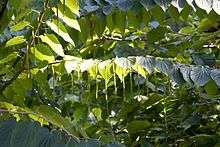Tetracentron sinense
Tetracentron sinense is a flowering plant native to Asia and the sole living species in the genus Tetracentron. It was formerly considered the sole species in the family Tetracentraceae, though Tetracentron is now included in the family Trochodendraceae together with the genus Trochodendron.
| Tetracentron sinense | |
|---|---|
 | |
| Tetracentron sinense, leaves and flowers | |
| Scientific classification | |
| Kingdom: | Plantae |
| Clade: | Tracheophytes |
| Clade: | Angiosperms |
| Clade: | Eudicots |
| Order: | Trochodendrales |
| Family: | Trochodendraceae |
| Genus: | Tetracentron |
| Species: | T. sinense |
| Binomial name | |
| Tetracentron sinense | |
Range
It is native to southern China and the eastern Himalaya, where it grows at altitudes of 1,100–3,500 m (3,600–11,500 ft) in a temperate climate. T. sinense has no widely used common name in English, though is sometimes called "spur-leaf".
Morphology
It is a tree growing to 20–40 m (66–131 ft) tall. The leaves are deciduous (the Flora of China reporting it as evergreen is an error), borne singly at the apex of short spur shoots, each leaf dark green, broad heart-shaped, 5–13 cm (2.0–5.1 in) long and 4–10 cm (1.6–3.9 in) broad, with a rugose surface and a serrated margin. The spur shoots bear a one leaf each year, slowly lengthening with each subsequent year.
The flowers are inconspicuous, yellowish green, without petals, produced on slender catkins 10–15 cm (3.9–5.9 in) long; each flower is 1–2 mm (0.039–0.079 in) diameter. The fruit is a follicle 2–5 mm (0.079–0.197 in) diameter, containing 4-6 seeds.
Tetracentron and Trochodendron share the very unusual feature of lacking vessel elements in the wood, something not typical in angiosperms. This has long been considered a very primitive character, resulting in the classification of these two genera in a basal position in the angiosperms; however, molecular phylogenetics research by the Angiosperm Phylogeny Group and others has shown that these two genera are not basal angiosperms, but related basal eudicots.[1][2] This suggests that the absence of vessel elements in this group is a secondarily evolved character, not a primitive one.
References
- Andreas Worberg, Dietmar Quandt, Anna-Magdalena Barniske, Cornelia Löhne, Khidir W. Hilu, and Thomas Borsch. 2007. "Phylogeny of basal eudicots: Insights from non-coding and rapidly evolving DNA." Organisms Diversity and Evolution 7(1):55-77. (see "External links" below).
- Burleigh, J. Gordon; Hilu, Khidir W.; Soltis, Douglas E. (2009). "Inferring phylogenies with incomplete data sets: a 5-gene, 567-taxon analysis of angiosperms". BMC Evolutionary Biology. 9 (1): 61. doi:10.1186/1471-2148-9-61.